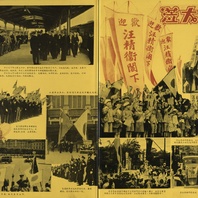
Item
An di Dongjing; li dashiguan (Arriving safely in Tokyo; visiting the embassy)
This photomontage is taken from Huang Qingshu (ed), Wang zhuxi fang Ri jinian huakan (Special pictorial in commemoration of Chairman Wang’s visit to Japan) (Nanjing: Xuanchuanbu, 1941). It includes images of Wang Jingwei arriving in Tokyo during his 1941 visit to Japan, and specifically his visit to the RNG embassy in Tokyo.
Read More
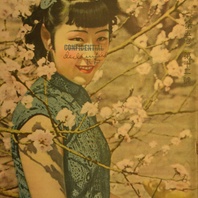
Item
Xin Zhonghua huabao (New China Pictorial) cover, December 1943
This cover image from the Xin Zhonghua huabao (New China Pictorial) 5.12 (December 1943) shows a colourised photograph of an unidentified “modern girl”. The New China Pictorial was a bilingual (Chinese-English) magazine published from 1939 through 1944 in Shanghai by the occupation journalist Wu Linzhi for distribution in China and throughout Southeast Asia.
Read More
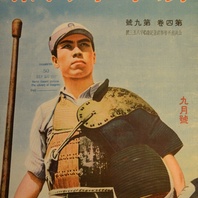
Item
Xin Zhonghua huabao (New China Pictorial) cover, September 1942
This cover image from the New China Pictorial 4.9 (September 1942) shows an unnamed member of the Chinese collaborationist forces in the outfit of a kendoka. There is little to identify this image (almost certainly created by the news agency Dōmei, as it was used as the cover image for the Japanese-language Dōmei Graph in October 1942) as being of a Chinese man, other than the inclusion of the Nationalist Chinese (white sun) insignia on his cap. The same image was used in later propaganda celebrating the collaborationist government’s declaration of war on the Allies. This was the only cover image from this magazine which included a male figure. The New China Pictorial was a bilingual (Chinese-English) published from 1939 through 1944 in Shanghai by the occupation journalist Wu Linzhi for distribution in China and throughout Southeast Asia.
Read More
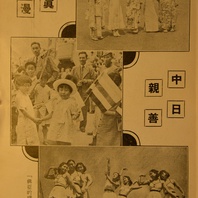
Item
Zhong-Ri qinshan, tianzhen lanman (Sino-Japanese amity, innocent and unaffected)
This series of unattributed photographs is taken from the Daminhui publication Xin Zhongguo (New China) 3.1 (January 1940). They are used here to present scenes of “Sino-Japanese friendship”. In the top two images, Chinese and Japanese children greet each other and waves the flag of Japan and of the Reformed Government of the Republic of China (RGROC). In the image at the bottom of the page, some unnamed performers do an “autumn dance” (qiu wu) entitled “Xing Ya de shuguang” (The light of a revitalized Asia).
Read More
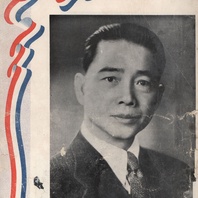
Item
H. E. Mr Wang Ching-wei
This supplement was published by the Ministry of Publicity (Xuanchuanbu) on the very day that Wang Jingwei officially “returned” to Nanjing to take up the reins of government under Japanese occupation. The symbols attached to this image (e.g., the KMT “white sun” ensign, and the colours of the ROC flag) suggest a “return” to pre-war norms. The presence of the Japanese is not so much as mentioned here.
Read More
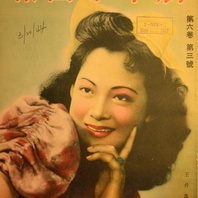
Item
Xin Zhonghua huabao (New China Pictorial) cover, March 1944
This cover image from the Xin Zhonghua huabao (New China Pictorial) 6.3 (March 1944) shows a colourised photograph of Wang Danfeng. Wang was a popular film celebrity in wartime Shanghai. The New China Pictorial was a bilingual (Chinese-English) magazine published from 1939 through 1944 in Shanghai by the occupation journalist Wu Linzhi for distribution in China and throughout Southeast Asia.
Read More
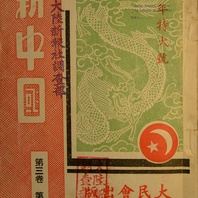
Item
Xin Zhongguo (New China) cover, January 1940
This is the cover image of the magazine Xin Zhongguo (New China) 3.1 (January 1940), published by the Daminhui (Great People’s Association) in Nanjing. The Daminhui was a propaganda and mobilization organization established by the Japanese in 1938, which was later folded into Wang Jingwei’s Kuomintang (Nationalist Party). The Daminhui specialised in public expressions of support for the occupation, and employed a staff of Chinese organisers, artists, and writers. The sun-and-moon logo of the Daminhui can be seen on this magazine’s cover. The untitled woodcut image of the dragon is unattributed. It is included here to coincide with the New Year (which this issue of Xin Zhongguo celebrates). Significantly, text on the magazine’s cover suggests that this copy of New China was once owned by investigations department of the Japanese-language, China-based newspaper, the Tairiku Shinpō.
Read More
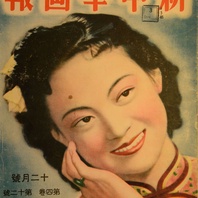
Item
Xin Zhonghua huabao (New China Pictorial) cover, December 1942
This cover from the Xin Zhonghua huabao (New China Pictorial) 4.12 (December 1942) features an image of Li Lihua. Li was one of the most popular film celebrities in wartime Shanghai, and was favoured by the occupation regime in pro-government media. The New China Pictorial was a bilingual (Chinese-English) magazine published from 1939 through 1944 in Shanghai by the occupation journalist Wu Linzhi for distribution in China and throughout Southeast Asia.
Read More
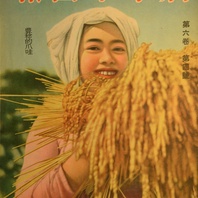
Item
Xin Zhonghua huabao (New China Pictorial) cover, April 1944
This cover from the Xin Zhonghua huabao (New China Pictorial) 6.4 (April 1944) shows an image of an unnamed Javanese woman harvesting rice. Harvesting had been a common theme of propaganda in areas conquered by the Japanese (including Manchukuo and China) since at least the early 1930s. The New China Pictorial was a bilingual (Chinese-English) magazine published from 1939 through 1944 in Shanghai by the occupation journalist Wu Linzhi for distribution in China and throughout Southeast Asia. This magazine employed cover images of women from areas of Southeast Asia that had been occupied by Japan with increasing regularity over the course of 1943 and 1944, having previously focused on Chinese film celebrities.
Read More
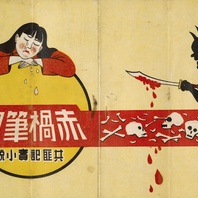
Item
Chihuo biji: Gongfei jishi xiaoshuo(A record of the Red Peril: A novel recording the deeds of the Communist bandits)
This book, almost certainly produced by the Japanese military, tells the story of communist violence against Chinese peasants in wartime Shanxi, and the escape of an anti-communist Chinese peasant girl to occupied Beijing. It was clearly written to discourage civilian support for the communist resistance in north China, and to foster peasant support for the newly-established PGROC early in the occupation. The weeping peasant woman is juxtaposed to the sinister “devil” that is international communism.
Read More
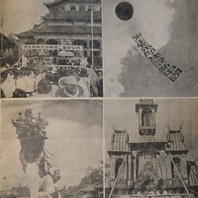
Item
Celebratory ceremony marking the second anniversary of Guangdong’s ‘rebirth’
This series of photographs is taken from Huanan huabao (South China graphic) 2.6 (1940), and shows celebrations to mark the second anniversary of what the Japanese referred to as the “rebirth” of Guangzhou (i.e., the fall of Guangzhou) in October 1938. Note the prominence given to the Sun Yat-sen Memorial Hall, as well as the use of “folk” forms of cultural expression.
Read More
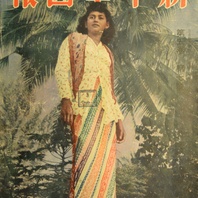
Item
Xin Zhonghua huabao (New China Pictorial) cover, July 1943
This cover image from the Xin Zhonghua huabao (New China Pictorial) 5.7 (July 1943) shows a colourised photograph of an unnamed woman, probably from Malaya. The New China Pictorial was a bilingual (Chinese-English) magazine published from 1939 through 1944 in Shanghai by the occupation journalist Wu Linzhi for distribution in China and throughout Southeast Asia. This magazine employed cover images of women from areas of Southeast Asia that had been conquered by Japan with increasing regularity over the course of 1943 and 1944, having previously focused on Chinese film celebrities.